oil pressure TOYOTA HIGHLANDER HYBRID 2020 Owners Manual (in English)
[x] Cancel search | Manufacturer: TOYOTA, Model Year: 2020, Model line: HIGHLANDER HYBRID, Model: TOYOTA HIGHLANDER HYBRID 2020Pages: 572, PDF Size: 21.11 MB
Page 1 of 572
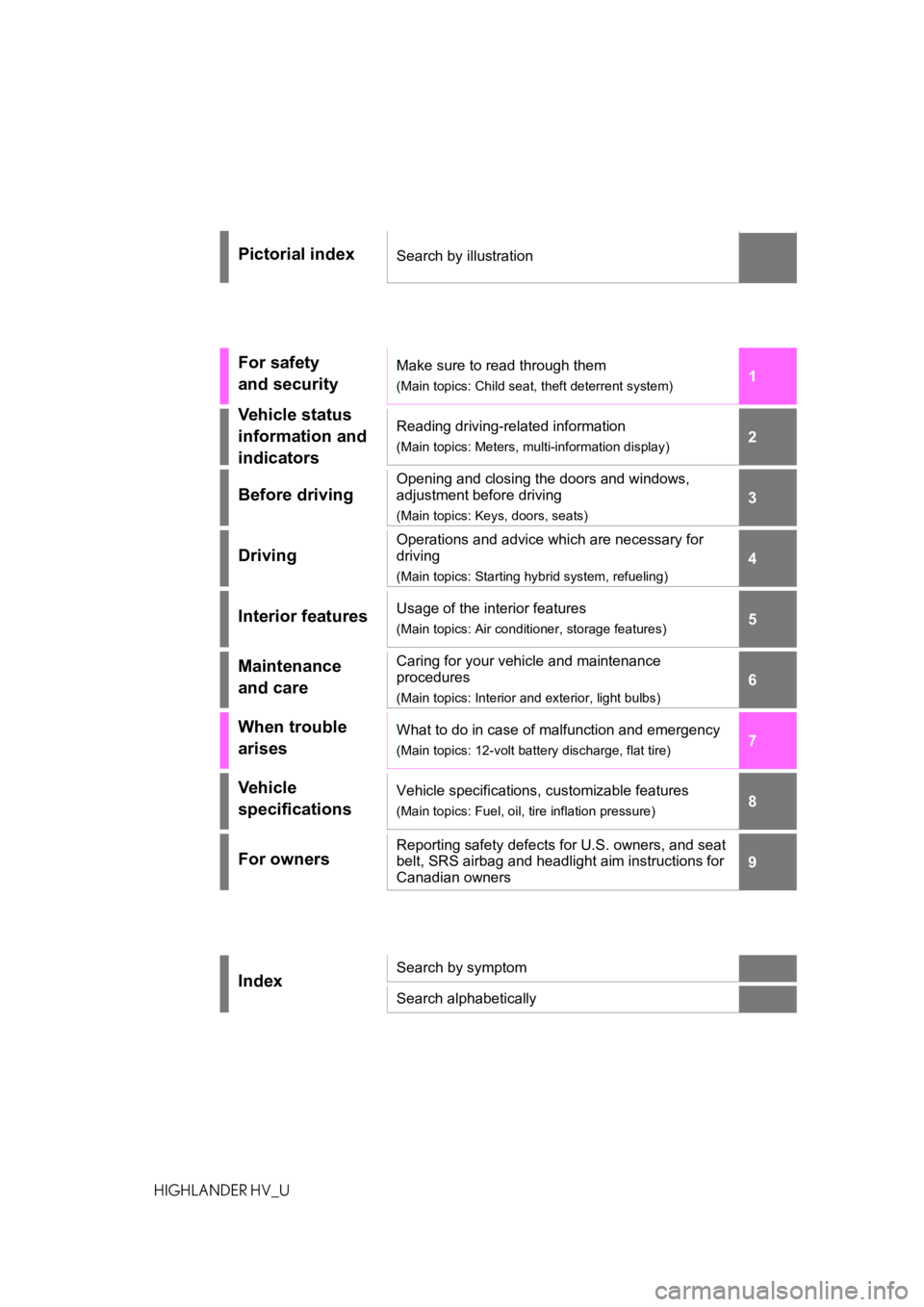
1
2
3
4
5
6
7
8
9
9
HIGHLANDER HV_U
Pictorial indexSearch by illustration
For safety
and securityMake sure to read through them
(Main topics: Child seat, theft deterrent system)
Vehicle status
information and
indicatorsReading driving-related information
(Main topics: Meters, multi-information display)
Before driving
Opening and closing the doors and windows,
adjustment before driving
(Main topics: Keys, doors, seats)
Driving
Operations and advice which are necessary for
driving
(Main topics: Starting hybrid system, refueling)
Interior featuresUsage of the interior features
(Main topics: Air conditioner, storage features)
Maintenance
and careCaring for your vehicle and maintenance
procedures
(Main topics: Interior and exterior, light bulbs)
When trouble
arisesWhat to do in case of malfunction and emergency
(Main topics: 12-volt battery discharge, flat tire)
Vehicle
specificationsVehicle specifications, customizable features
(Main topics: Fuel, oil, tire inflation pressure)
For ownersReporting safety defects for U.S. owners, and seat
belt, SRS airbag and headlight aim instructions for
Canadian owners
IndexSearch by symptom
Search alphabetically
Page 4 of 572
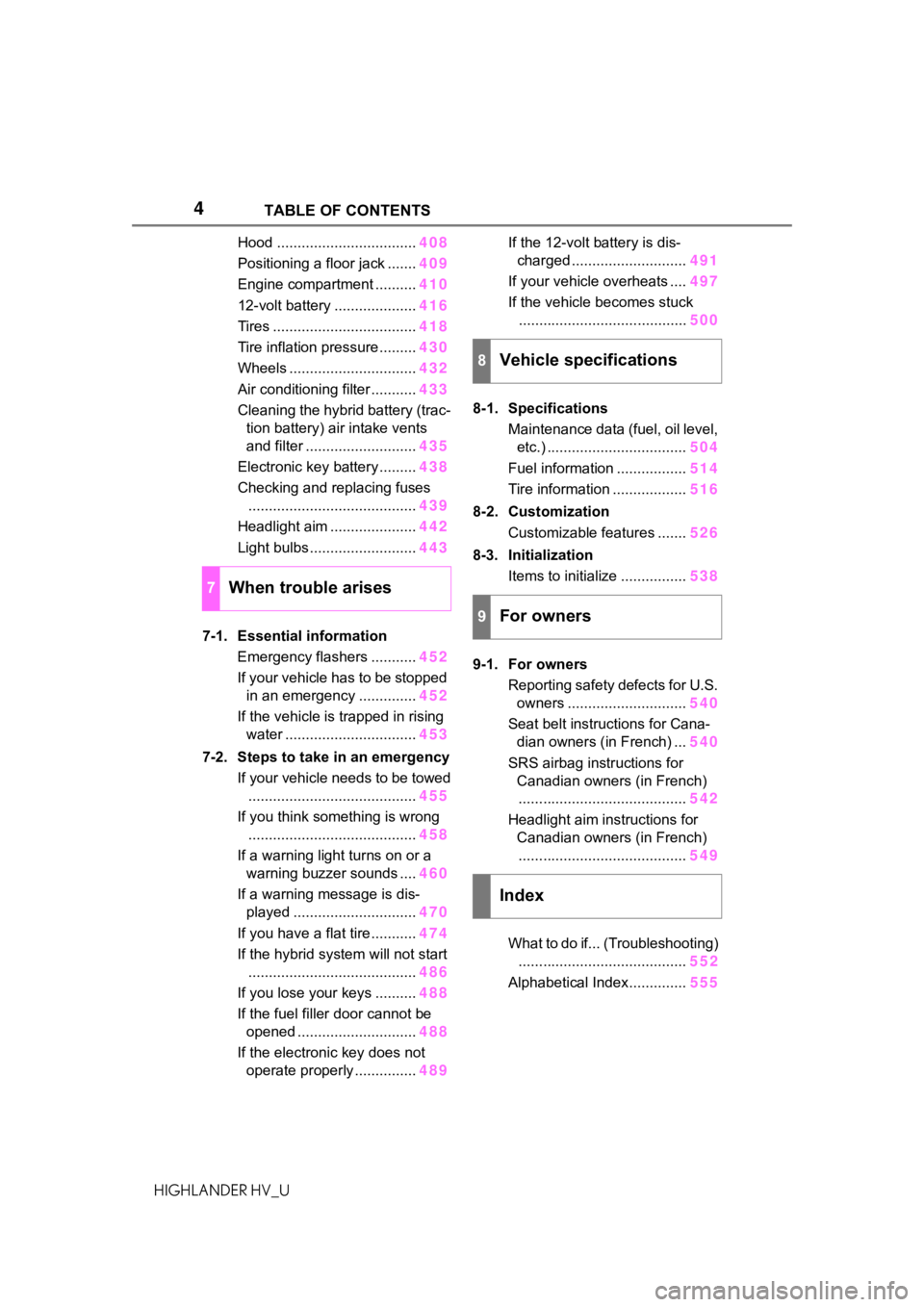
4TABLE OF CONTENTS
HIGHLANDER HV_U
Hood ..................................408
Positioning a floor jack ....... 409
Engine compartment .......... 410
12-volt battery .................... 416
Tires ................................... 418
Tire inflation pressure......... 430
Wheels ............................... 432
Air conditioning filter ........... 433
Cleaning the hybrid battery (trac- tion battery) air intake vents
and filter ........................... 435
Electronic key battery ......... 438
Checking and replacing fuses ......................................... 439
Headlight aim ..................... 442
Light bulbs .......................... 443
7-1. Essential information Emergency flashers ........... 452
If your vehicle has to be stopped in an emergency .............. 452
If the vehicle is trapped in rising water ................................ 453
7-2. Steps to take in an emergency If your vehicle needs to be towed......................................... 455
If you think something is wrong ......................................... 458
If a warning light turns on or a warning buzzer sounds .... 460
If a warning message is dis- played .............................. 470
If you have a flat tire ........... 474
If the hybrid system will not start ......................................... 486
If you lose your keys .......... 488
If the fuel filler door cannot be opened ............................. 488
If the electronic key does not operate properly ............... 489If the 12-volt battery is dis-
charged ............................ 491
If your vehicle overheats .... 497
If the vehicle becomes stuck ......................................... 500
8-1. Specifications Maintenance data (fuel, oil level, etc.) .................................. 504
Fuel information ................. 514
Tire information .................. 516
8-2. Customization Customizable features ....... 526
8-3. Initialization Items to initialize ................ 538
9-1. For owners Reporting safety defects for U.S. owners ............................. 540
Seat belt instructions for Cana- dian owners (in French) ... 540
SRS airbag instructions for Canadian owners (in French)......................................... 542
Headlight aim instructions for Canadian owners (in French)......................................... 549
What to do if... (Troubleshooting) ......................................... 55
2
Alphab
etical Index.............. 555
7When trouble arises
8Vehicle specifications
9For owners
Index
Page 13 of 572
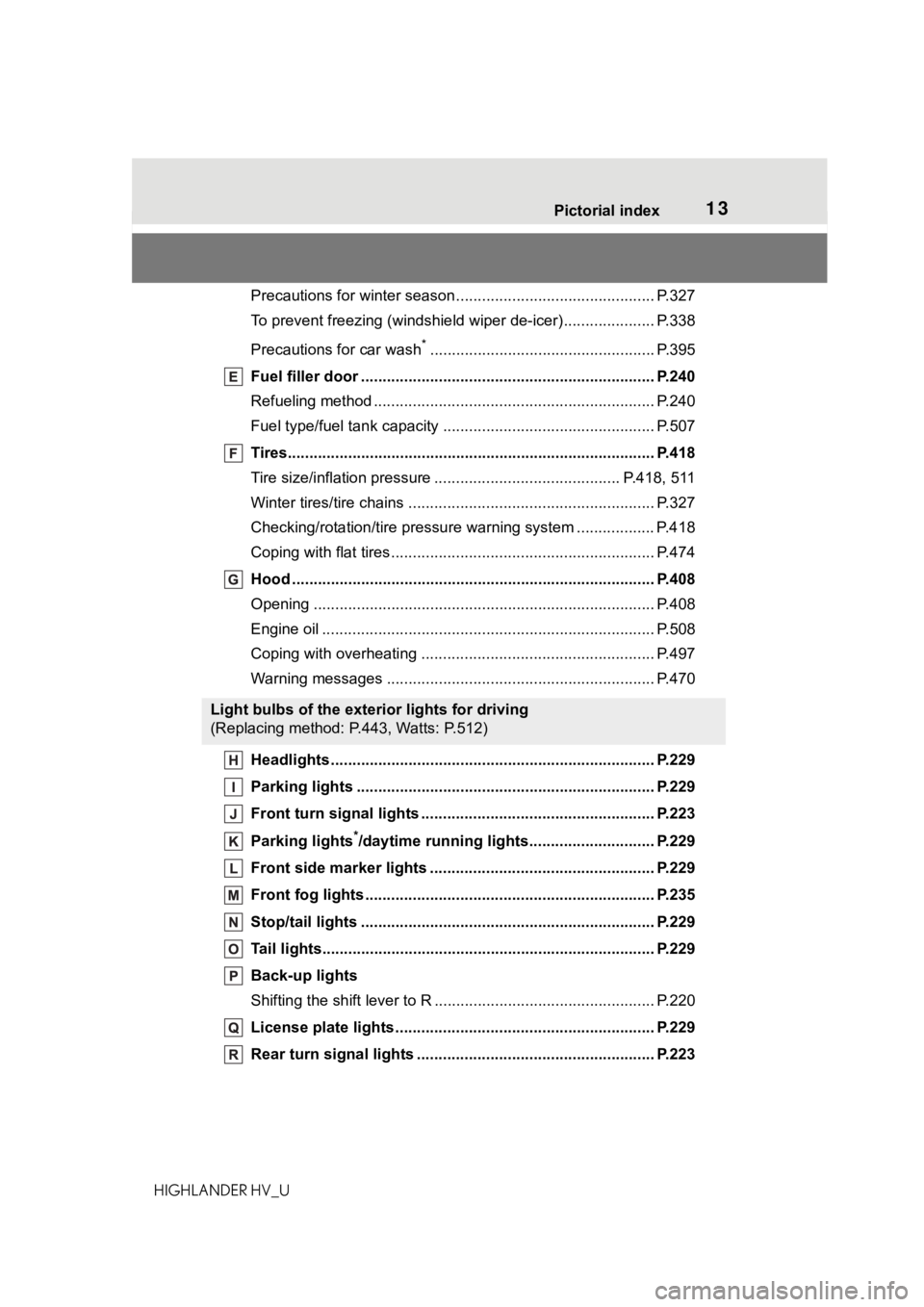
13Pictorial index
HIGHLANDER HV_U
Precautions for winter seas on.............................................. P.327
To prevent freezing (windshiel d wiper de-icer) ..................... P.338
Precautions for car wash
*.................................................... P.395
Fuel filler door ............................................... ..................... P.240
Refueling method ............................................... .................. P.240
Fuel type/fuel tan k capacity ................................... .............. P.507
Tires.......................................................... ........................... P.418
Tire size/inflation pressure ................................... ........ P.418, 511
Winter tires/tire chains ....................................... .................. P.327
Checking/rotation/tire pressur e warning system ..................P.418
Coping with flat tires......................................... .................... P.474
Hood ........................................................... ......................... P.408
Opening ............................................................................... P.408
Engine oil ..................................................... ........................ P.508
Coping with overheating ...................................................... P.497
Warning messages ............................................... ............... P.470
Headlights..................................................... ...................... P.229
Parking lights ................................................. .................... P.229
Front turn signal lights ....................................... ............... P.223
Parking lights
*/daytime running lights............................. P.229
Front side marker lights ....................................... ............. P.229
Front fog lights ............................................... .................... P.235
Stop/tail lights ............................................... ..................... P.229
Tail lights.................................................... ......................... P.229
Back-up lights
Shifting the shift lever to R ................................................... P.220
License plate lights........................................... ................. P.229
Rear turn signal lights ........................................ ............... P.223
Light bulbs of the exterior lights for driving
(Replacing method: P.443, Watts: P.512)
Page 85 of 572
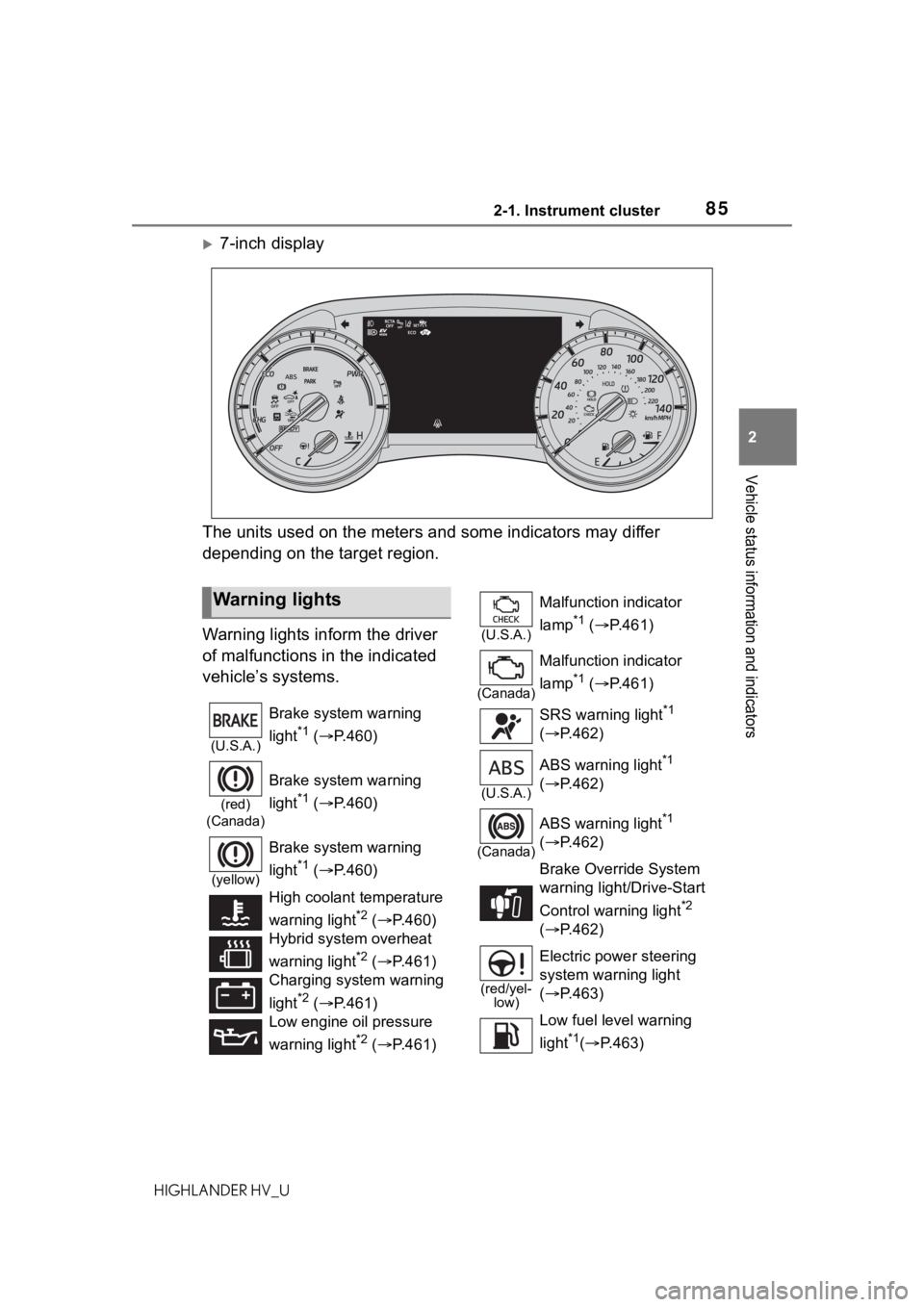
852-1. Instrument cluster
HIGHLANDER HV_U
2
Vehicle status information and indicators
7-inch display
The units used on the meters and some indicators may differ
depending on the target region.
Warning lights inform the driver
of malfunctions in the indicated
vehicle’s systems.
Warning lights
(U.S.A.)
Brake system warning
light
*1 ( P.460)
(red)
(Canada)
Brake system warning
light
*1 ( P.460)
(yellow)
Brake system warning
light
*1 ( P.460)
High coolant temperature
warning light
*2 ( P.460)
Hybrid system overheat
warning light
*2 ( P.461)
Charging system warning
light
*2 ( P.461)
Low engine oil pressure
warning light
*2 ( P.461)
(U.S.A.)
Malfunction indicator
lamp
*1 ( P.461)
(Canada)
Malfunction indicator
lamp
*1 ( P.461)
SRS warning light
*1
( P.462)
(U.S.A.)
ABS warning light*1
( P.462)
(Canada)
ABS warning light*1
( P.462)
Brake Overri de System
warning light/Drive-Start
Control warning light
*2
( P.462)
(red/yel-
low)
Electric power steering
system warning light
( P.463)
Low fuel leve l warning
light
*1( P.463)
Page 327 of 572
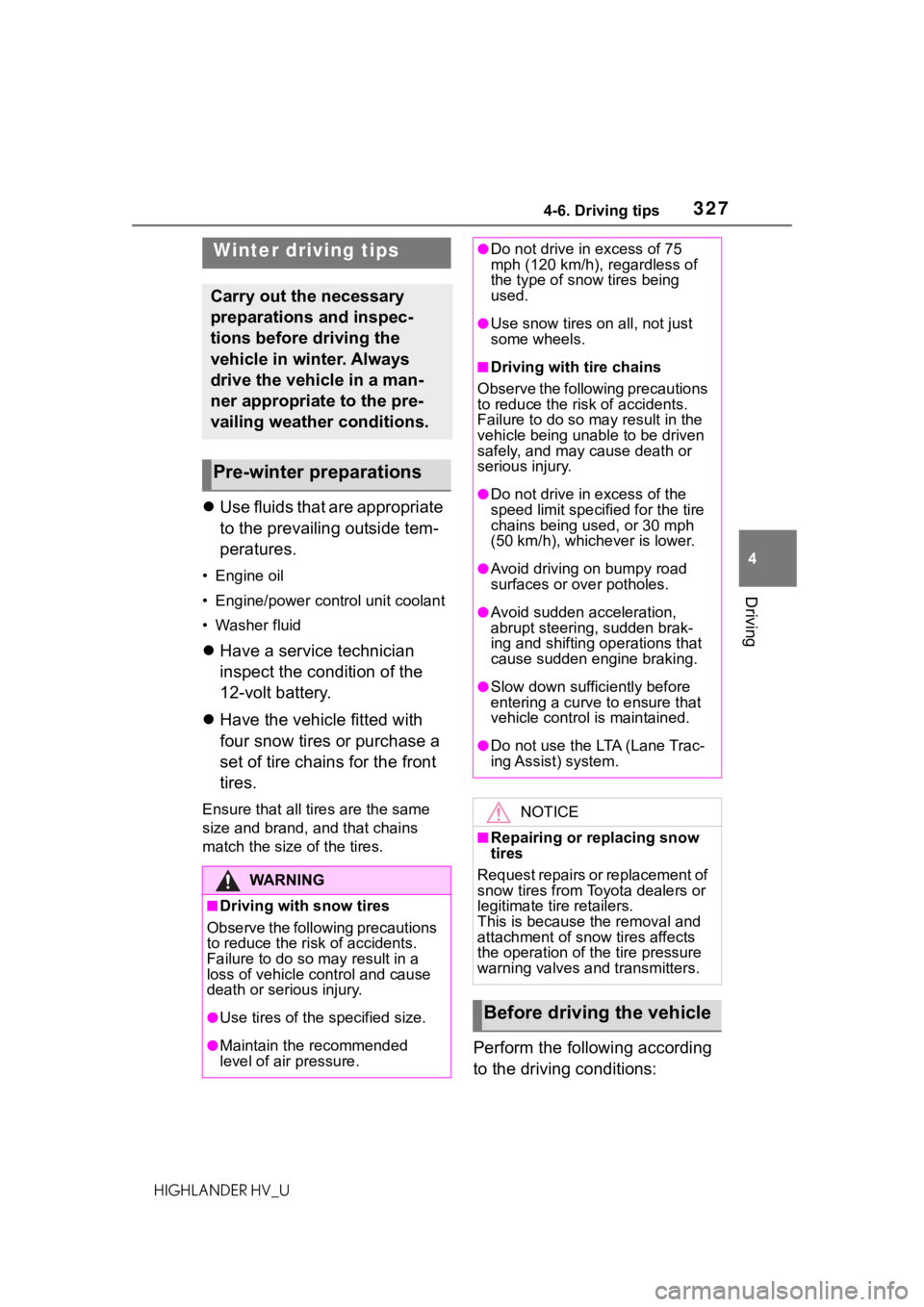
3274-6. Driving tips
HIGHLANDER HV_U
4
Driving
Use fluids that are appropriate
to the prevailing outside tem-
peratures.
• Engine oil
• Engine/power control unit coolant
• Washer fluid
Have a service technician
inspect the condition of the
12-volt battery.
Have the vehicle fitted with
four snow tires or purchase a
set of tire chains for the front
tires.
Ensure that all tires are the same
size and brand, and that chains
match the size of the tires.
Perform the following according
to the driving conditions:
Winter driving tips
Carry out the necessary
preparations and inspec-
tions before driving the
vehicle in winter. Always
drive the vehicle in a man-
ner appropriate to the pre-
vailing weather conditions.
Pre-winter preparations
WA R N I N G
■Driving with snow tires
Observe the following precautions
to reduce the risk of accidents.
Failure to do so m ay result in a
loss of vehicle control and cause
death or serious injury.
●Use tires of the specified size.
●Maintain the recommended
level of air pressure.
●Do not drive in excess of 75
mph (120 km/h), regardless of
the type of snow tires being
used.
●Use snow tires on all, not just
some wheels.
■Driving with tire chains
Observe the following precautions
to reduce the risk of accidents.
Failure to do so may result in the
vehicle being unable to be driven
safely, and may cause death or
serious injury.
●Do not drive in excess of the
speed limit specifi ed for the tire
chains being used, or 30 mph
(50 km/h), whichever is lower.
●Avoid driving on bumpy road
surfaces or over potholes.
●Avoid sudden acceleration,
abrupt steering, sudden brak-
ing and shifting operations that
cause sudden engine braking.
●Slow down sufficiently before
entering a curve to ensure that
vehicle control is maintained.
●Do not use the LTA (Lane Trac-
ing Assist) system.
NOTICE
■Repairing or replacing snow
tires
Request repairs or replacement of
snow tires from Toyota dealers or
legitimate tire retailers.
This is because the removal and
attachment of snow tires affects
the operation of the tire pressure
warning valves and transmitters.
Before driving the vehicle
Page 394 of 572
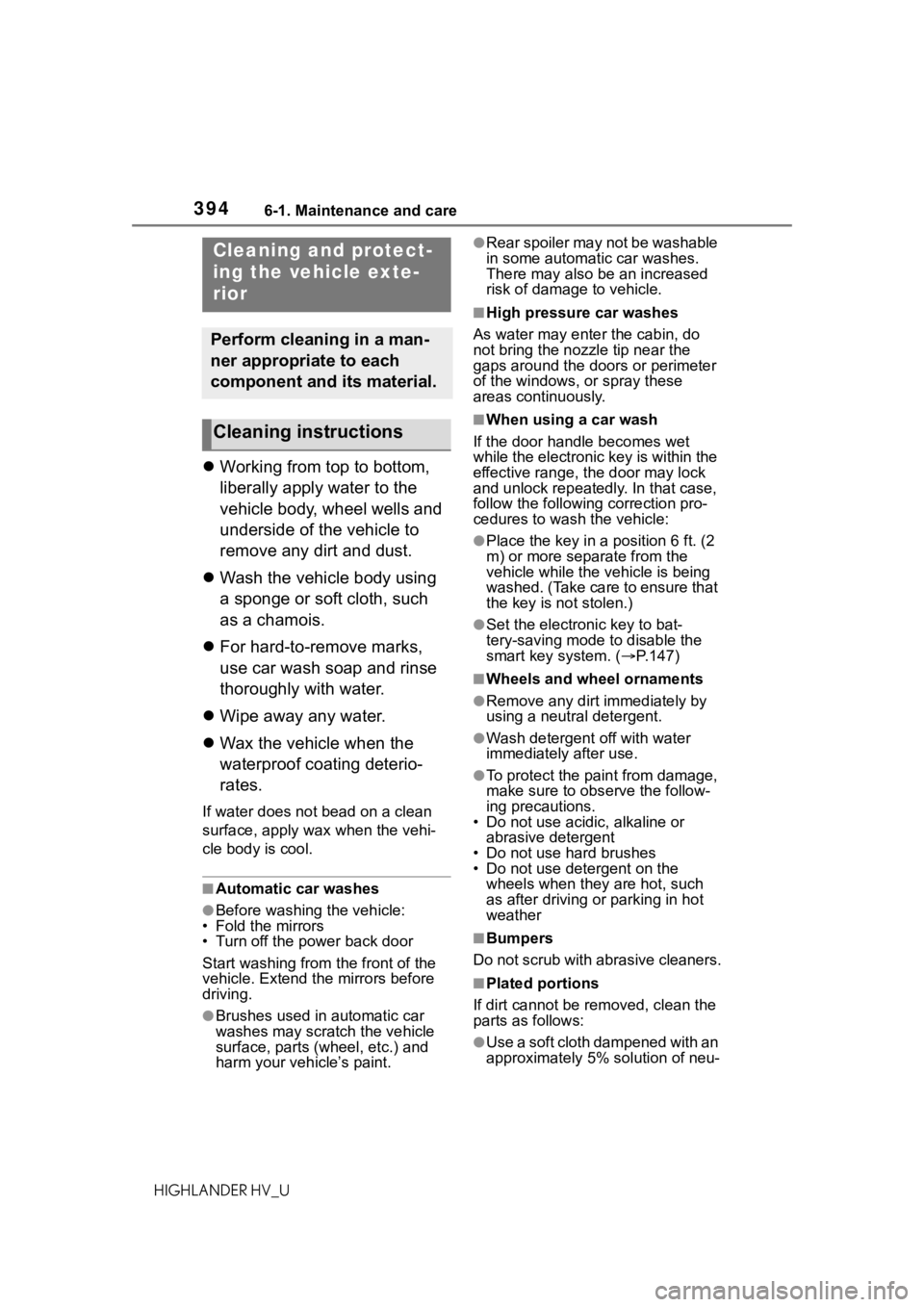
3946-1. Maintenance and care
HIGHLANDER HV_U
6-1.Maintenance and care
Working from top to bottom,
liberally apply water to the
vehicle body, wheel wells and
underside of the vehicle to
remove any dirt and dust.
Wash the vehicle body using
a sponge or soft cloth, such
as a chamois.
For hard-to-remove marks,
use car wash soap and rinse
thoroughly with water.
Wipe away any water.
Wax the vehicle when the
waterproof coating deterio-
rates.
If water does not bead on a clean
surface, apply wax when the vehi-
cle body is cool.
■Automatic car washes
●Before washing the vehicle:
• Fold the mirrors
• Turn off the power back door
Start washing from the front of the
vehicle. Extend the mirrors before
driving.
●Brushes used in automatic car
washes may scratch the vehicle
surface, parts (wheel, etc.) and
harm your vehicle’s paint.
●Rear spoiler may not be washable
in some automatic car washes.
There may also be an increased
risk of damage to vehicle.
■High pressure car washes
As water may enter the cabin, do
not bring the nozzle tip near the
gaps around the doors or perimeter
of the windows, or spray these
areas continuously.
■When using a car wash
If the door handle becomes wet
while the electronic key is within the
effective range, the door may lock
and unlock repeatedly. In that case,
follow the following correction pro-
cedures to wash the vehicle:
●Place the key in a position 6 ft. (2
m) or more separate from the
vehicle while the vehicle is being
washed. (Take care to ensure that
the key is not stolen.)
●Set the electronic key to bat-
tery-saving mode to disable the
smart key system. ( P.147)
■Wheels and wheel ornaments
●Remove any dirt immediately by
using a neutral detergent.
●Wash detergent off with water
immediately after use.
●To protect the paint from damage,
make sure to obs erve the follow-
ing precautions.
• Do not use acidic, alkaline or abrasive detergent
• Do not use hard brushes
• Do not use detergent on the wheels when they are hot, such
as after driving or parking in hot
weather
■Bumpers
Do not scrub with abrasive cleaners.
■Plated portions
If dirt cannot be re moved, clean the
parts as follows:
●Use a soft cloth dampened with an
approximately 5% solution of neu-
Cleaning and protect-
ing the vehicle exte-
rior
Perform cleaning in a man-
ner appropriate to each
component and its material.
Cleaning instructions
Page 407 of 572

4076-3. Do-it-yourself maintenance
HIGHLANDER HV_U
6
Maintenance and care
Hybrid battery
(traction bat-
tery) air intake
vent ( P.435)• Vacuum cleaner,
etc.
• Phillips screw- driver
Headlight aim
( P.442)• Phillips-head
screwdriver
Light bulbs
( P.443)
• Bulb with same
number and
wattage rating as
original
• Flathead screw- driver
• Wrench
Radiator and
condenser
( P.414)
Tire inflation
pressure
( P.430)• Tire pressure
gauge
• Compressed air source
Washer fluid
( P.415)
• Water or washer
fluid containing
antifreeze (for
winter use)
• Funnel (used only for adding
water or washer
fluid)
WA R N I N G
The engine compartment contains
many mechanisms and fluids that
may move suddenly, become hot,
or become electrically energized.
To avoid death or serious injury,
observe the following precautions.
ItemsParts and tools■When working on the engine
compartment
●Make sure that the “ACCES-
SORY” or “IGNITION ON” on
the multi-information display
and the “READY” indicator are
both off.
●Keep hands, clothing and tools
away from the moving fan and
engine drive belt.
●Be careful not to touch the
engine, power control unit, radi-
ator, exhaust manifold, etc. right
after driving as they may be hot.
Oil and other fluids may also be
hot.
●Do not leave anything that may
burn easily, such as paper and
rags, in the engine compart-
ment.
●Do not smoke, c ause sparks or
expose an open flame to fuel or
the battery. Fuel and battery
fumes are flammable.
■When working near the elec-
tric cooling fan or radiator
grille
Be sure the power switch is off.
With the power switch in ON, the
electric cooling fa n may automati-
cally start to run if the air condi-
tioning is on and/or the coolant
temperature is high. ( P.414)
■Safety glasses
Wear safety glasses to prevent
flying or falling material, fluid
spray, etc. from getting in your
eyes.
NOTICE
■If you remove the air cleaner
filter
Driving with the ai r cleaner filter
removed may cause excessive
engine wear due to dirt in the air.
Page 432 of 572
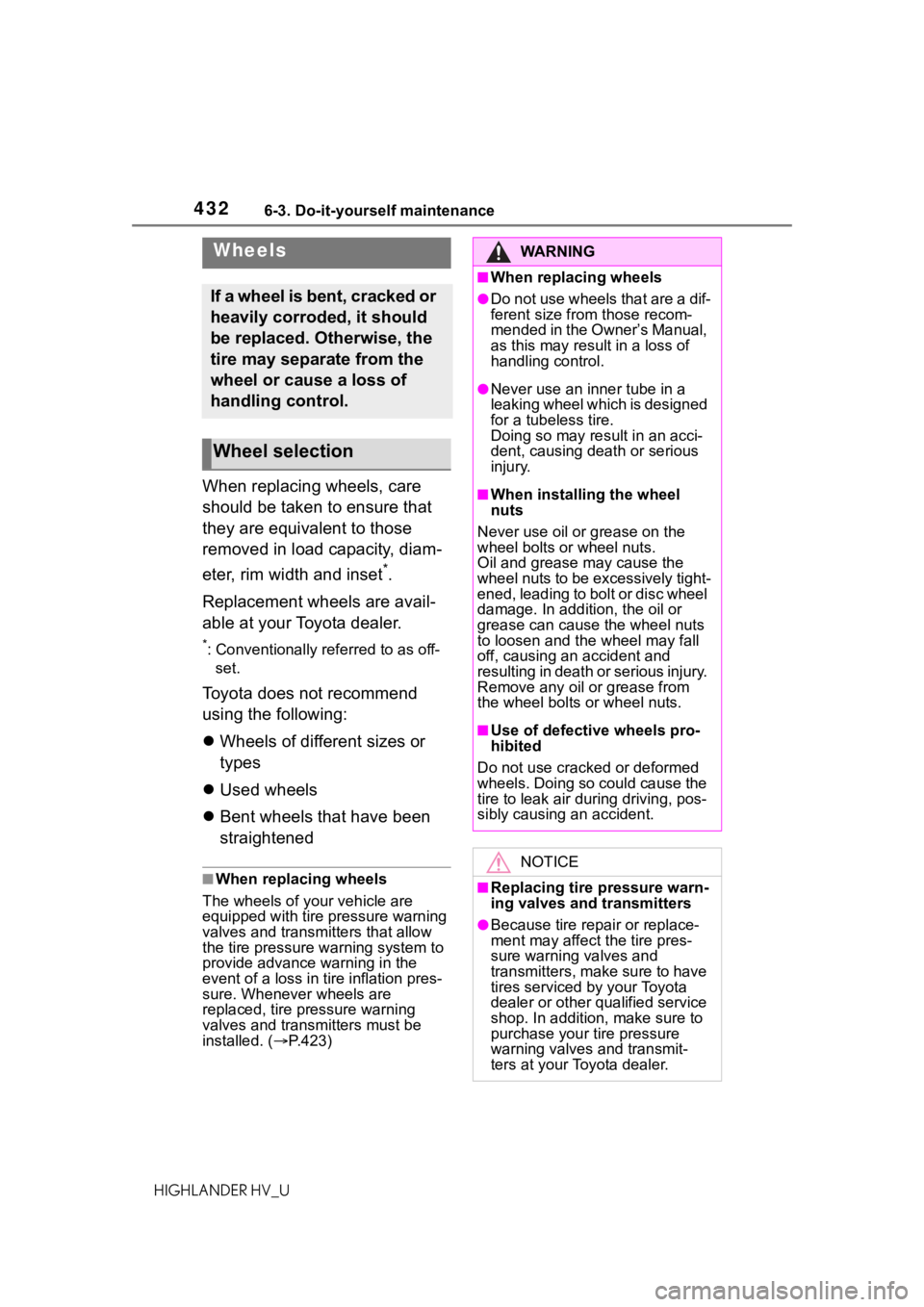
4326-3. Do-it-yourself maintenance
HIGHLANDER HV_U
When replacing wheels, care
should be taken to ensure that
they are equivalent to those
removed in load capacity, diam-
eter, rim width and inset
*.
Replacement wheels are avail-
able at your Toyota dealer.
*: Conventionally referred to as off- set.
Toyota does not recommend
using the following:
Wheels of different sizes or
types
Used wheels
Bent wheels that have been
straightened
■When replacing wheels
The wheels of your vehicle are
equipped with tire pressure warning
valves and transmit ters that allow
the tire pressure warning system to
provide advance warning in the
event of a loss in tire inflation pres-
sure. Whenever wheels are
replaced, tire pressure warning
valves and transmitters must be
installed. ( P.423)
Wheels
If a wheel is bent, cracked or
heavily corroded, it should
be replaced. Otherwise, the
tire may separate from the
wheel or cause a loss of
handling control.
Wheel selection
WA R N I N G
■When replacing wheels
●Do not use wheels that are a dif-
ferent size from those recom-
mended in the Owner’s Manual,
as this may result in a loss of
handling control.
●Never use an inner tube in a
leaking wheel which is designed
for a tubeless tire.
Doing so may result in an acci-
dent, causing death or serious
injury.
■When installing the wheel
nuts
Never use oil or grease on the
wheel bolts or wheel nuts.
Oil and grease may cause the
wheel nuts to be excessively tight-
ened, leading to bolt or disc wheel
damage. In addition, the oil or
grease can cause the wheel nuts
to loosen and the wheel may fall
off, causing an accident and
resulting in death or serious injury.
Remove any oil or grease from
the wheel bolts or wheel nuts.
■Use of defective wheels pro-
hibited
Do not use cracke d or deformed
wheels. Doing so could cause the
tire to leak air during driving, pos-
sibly causing an accident.
NOTICE
■Replacing tire pressure warn-
ing valves and transmitters
●Because tire repair or replace-
ment may affect the tire pres-
sure warning valves and
transmitters, make sure to have
tires serviced by your Toyota
dealer or other qualified service
shop. In additio n, make sure to
purchase your tire pressure
warning valves and transmit-
ters at your Toyota dealer.
Page 461 of 572
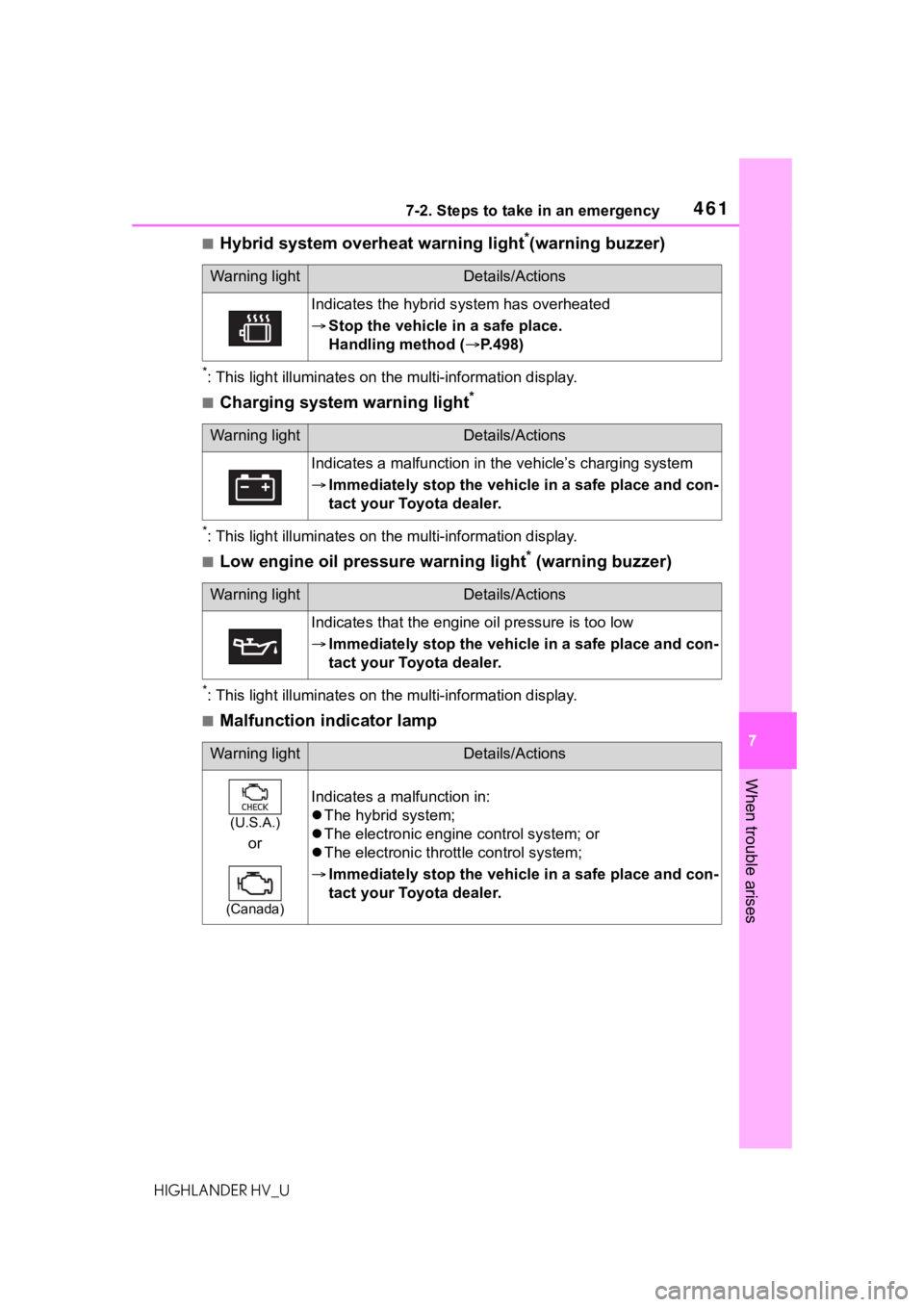
4617-2. Steps to take in an emergency
HIGHLANDER HV_U
7
When trouble arises
■Hybrid system overheat warning light*(warning buzzer)
*: This light illuminat es on the multi-information display.
■Charging system warning light*
*: This light illuminates on the multi-information display.
■Low engine oil pressure warning light* (warning buzzer)
*: This light illuminates on the multi-information display.
■Malfunction indicator lamp
Warning lightDetails/Actions
Indicates the hybrid s ystem has overheated
Stop the vehicle in a safe place.
Handling method ( P.498)
Warning lightDetails/Actions
Indicates a malfunction in the vehicle’s charging system
Immediately stop the vehicle in a safe place and con-
tact your Toyota dealer.
Warning lightDetails/Actions
Indicates that the engine oil pressure is too low
Immediately stop the vehicle in a safe place and con-
tact your Toyota dealer.
Warning lightDetails/Actions
(U.S.A.)
or
(Canada)
Indicates a malfunction in:
The hybrid system;
The electronic engine control system; or
The electronic thrott le control system;
Immediately stop the vehicle in a safe place and con-
tact your Toyota dealer.
Page 473 of 572
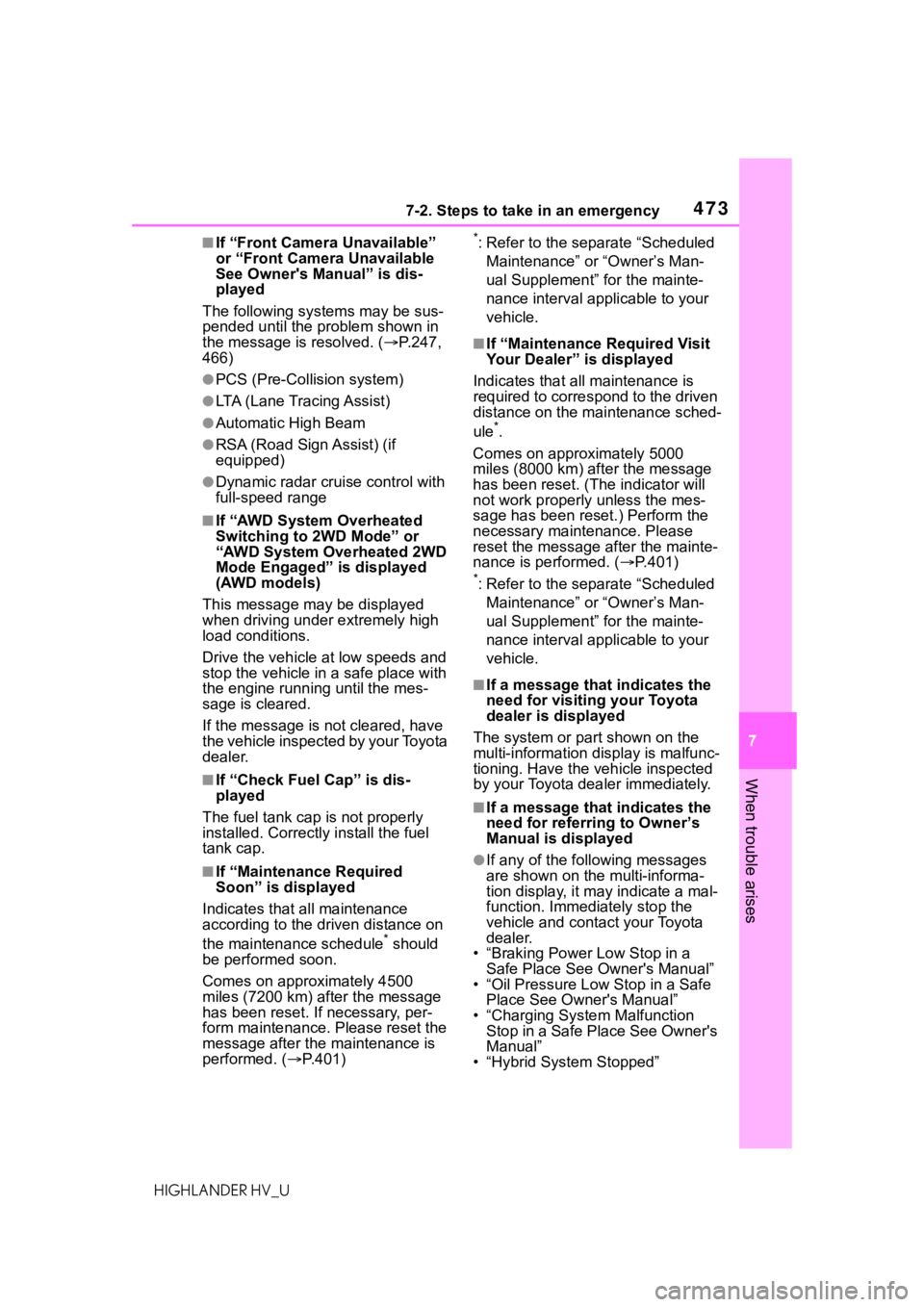
4737-2. Steps to take in an emergency
HIGHLANDER HV_U
7
When trouble arises
■If “Front Camera Unavailable”
or “Front Camera Unavailable
See Owner's Manual” is dis-
played
The following sys tems may be sus-
pended until the pr oblem shown in
the message is resolved. ( P.247,
466)
●PCS (Pre-Collision system)
●LTA (Lane Tracing Assist)
●Automatic High Beam
●RSA (Road Sign Assist) (if
equipped)
●Dynamic radar cruise control with
full-speed range
■If “AWD System Overheated
Switching to 2WD Mode” or
“AWD System Overheated 2WD
Mode Engaged” is displayed
(AWD models)
This message may be displayed
when driving under extremely high
load conditions.
Drive the vehicle at low speeds and
stop the vehicle in a safe place with
the engine running until the mes-
sage is cleared.
If the message is not cleared, have
the vehicle inspected by your Toyota
dealer.
■If “Check Fuel Cap” is dis-
played
The fuel tank cap is not properly
installed. Correctly install the fuel
tank cap.
■If “Maintenance Required
Soon” is displayed
Indicates that all maintenance
according to the dr iven distance on
the maintenance schedule
* should
be performed soon.
Comes on approximately 4500
miles (7200 km) after the message
has been reset. If necessary, per-
form maintenance. Please reset the
message after the maintenance is
performed. ( P.401)
*: Refer to the separate “Scheduled
Maintenance” or “Owner’s Man-
ual Supplement” for the mainte-
nance interval applicable to your
vehicle.
■If “Maintenance Required Visit
Your Dealer” is displayed
Indicates that all maintenance is
required to correspond to the driven
distance on the maintenance sched-
ule
*.
Comes on approximately 5000
miles (8000 km) after the message
has been reset. (The indicator will
not work properly unless the mes-
sage has been rese t.) Perform the
necessary maintenance. Please
reset the message after the mainte-
nance is performed. ( P.401)
*: Refer to the separate “Scheduled
Maintenance” or “Owner’s Man-
ual Supplement” for the mainte-
nance interval applicable to your
vehicle.
■If a message that indicates the
need for visiting your Toyota
dealer is displayed
The system or part shown on the
multi-information di splay is malfunc-
tioning. Have the vehicle inspected
by your Toyota dealer immediately.
■If a message that indicates the
need for referring to Owner’s
Manual is displayed
●If any of the following messages
are shown on the multi-informa-
tion display, it may indicate a mal-
function. Immediately stop the
vehicle and contact your Toyota
dealer.
• “Braking Power Low Stop in a Safe Place See Owner's Manual”
• “Oil Pressure Low Stop in a Safe
Place See Owner's Manual”
• “Charging System Malfunction Stop in a Safe Place See Owner's
Manual”
• “Hybrid System Stopped”